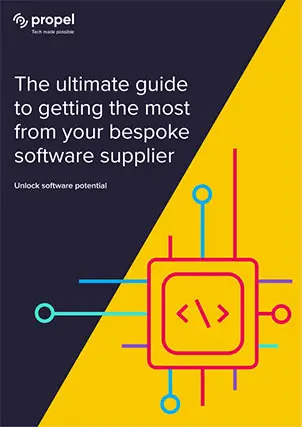Software migration plan
27/08/2024
The cost of software migration: Is it worth the investment?
Software migration is a significant decision that can have wide-ranging impacts on a business.
While the potential benefits are often clear—better service, improved quality, and cost savings— many of which you can read about in our client projects, the financial implications of switching suppliers or migrating software can seem daunting. Is it worth the investment? In this blog, we'll explore the costs involved in supplier and software migration projects and consider how to assess costs and the potential return on investment (ROI).
Software migrations can take various forms. It may be a simple migration to the cloud, an applications migration, or a full systems migration. You may even be looking to migrate your bespoke software provider, or at least considering the options.
Software migration planning starts with identifying the need you are trying to address. Be this ongoing support, team augmentation or specialist transformation projects, we have written a full guide to help you navigate the software migration and software supplier migration process.
The four cost stages of software migration you need to plan for:
Switching tech stack or your software supplier is not just a matter of signing a new contract. The process involves multiple phases, each with its own set of costs. We have compiled a transition plan document to guide you through every stage.

1. Evaluation costs:
- Conducting a thorough evaluation of potential software options and suppliers, including costs for resources, time spent by your team, and possibly external consultants. Using tools like a SWOT analysis or matrix can add depth but also time to the evaluation process.
- Contract review and negotiation:
- Legal fees for reviewing new contracts and ensuring that SLAs (Service Level Agreements) and terms align with your business needs.
2. Transition planning costs:
- Transition team assembly: Bringing together a dedicated team to oversee the migration can result in extra personnel costs, whether through hiring or reallocating existing staff.
- Communication plan development: Creating and executing a communication plan to keep all stakeholders informed. This could include internal communications, customer notifications, and updates to other suppliers.
- Risk assessment: Identifying potential risks and developing mitigation strategies may require additional resources, especially if your industry has specific regulatory requirements.
3. Execution phase costs:
- Transfer process: Coordinating the actual transfer of services, products, or systems can involve testing, implementation, and possibly temporary disruptions that could impact revenue.
- Data and information gathering: Ensuring all necessary data is transferred from your current supplier, including proprietary information, which may require additional resources or software.
- Quality control measures: Ensuring the new supplier meets your quality standards through inspections, testing, or audits can add up, particularly if you need to do this at multiple stages.
- Supplier training: Investing in training the new supplier to understand your business processes and expectations ensures a smooth transition but comes with a cost in time and resources.
4. Post-migration costs:
- Performance evaluations: After the migration, ongoing evaluations to ensure that the supplier is meeting performance expectations can involve both time and money.
- Feedback and continuous improvement: Collecting feedback and addressing any issues may require further adjustments and investments.
How can software migration save costs?
Looking to the long term - Calculating the ROI of software and software supplier migration:
While the costs can be substantial, the return on investment can, and should, make the switch worthwhile. Here are some key areas to evaluate potential ROI:
Faster development: Migrating your software will ensure you have the latest integrations and a new supplier or software stack may offer better pricing, either through lower unit costs or more favourable contract terms.
Greater efficiency: Updating your technology or migrating to a new supplier should, in the long term, lead to much-improved efficiency. Additionally, a more reliable supplier can lead to fewer disruptions, reducing downtime and increasing productivity.
Improved products or services: If the new software improves your customer experience or your supplier provides superior software products or services, you may see long-term savings through reduced returns, fewer defects, and higher customer satisfaction.
Innovation and flexibility: Software is ever-evolving and new updates can help you be more flexible, a new custom software supplier may be able to offer more innovative solutions that can help your business stay competitive, potentially opening up new revenue streams.
Risk reduction/ diversification: If you switch software that is easier to scale or to a supplier that provides more reliable services or has better disaster recovery plans, you can reduce the risks associated with supply chain disruptions.
Compliance and regulation: New software, processes and suppliers that better meet industry standards can help avoid costly penalties or legal issues.
Long-term partnership: Investing in new software or a new supplier that aligns with your long-term goals can create a strategic partnership that drives growth, innovation, and competitive advantage
Tips for assessing if migration is worth the Investment?
The decision to switch suppliers or software should be based on a careful analysis of both the costs and the potential ROI. Here are our tips to approach this:
1. ROI analysis:
Quantify the Costs: Tally up all the expenses associated with the migration, from preparation to post-transition.
Estimate the benefits: Calculate the potential savings, quality improvements, and risk reductions. Consider both short-term gains and long-term value.
2. Non-financial audit:
Customer Impact: Will the new supplier improve customer satisfaction, leading to increased loyalty and sales?
Employee impact: How will the transition affect your internal teams? Will it reduce workloads or improve morale?
3. Carry out software migration scenario planning:
What-If scenarios: Assess the risks of both switching and staying with your current software, and your existing supplier. What happens if the new software fails to deliver? Or your new supplier can’t live up to expectations? Is your back-out plan robust enough to mitigate these risks?
A final thought - Balancing cost and value to achieve cost-efficient software
“Ultimately, the question isn't just whether you can afford to switch suppliers—but whether you can afford not to.” Andrew Brown, Managing Director and Co-Owner - Propel Tech
If you’re considering a supplier or software migration and need expert guidance, our team is here to help. With years of experience in seamless transitions, we can help you navigate the process and maximise your investment.
Please don’t hesitate to get in touch with any questions or to discuss your specific software migration needs.







